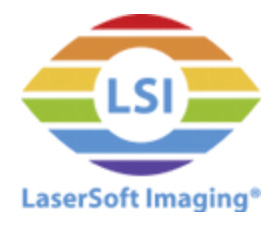 [ Disclaimer: I purchased this product for my own use. ]
[ Disclaimer: I purchased this product for my own use. ]
As filmmakers and media creators we continually need to convert still images, documents, slides and photographs into digital format. We scan at a wide range of resolutions so we can create animated moves. And we need these images to be the highest quality possible, with the least amount of dust, dirt or scratches, even when the originals are not in very good shape.
Oh, and we need them yesterday.
The purpose of scanning software is to digitize paper documents, photographs and transparencies into high-quality image files. This requires two principal components: hardware (the scanner) and software (the instructions on how to make it work).
Last week, I reviewed the Epson Perfection V600 Photo and Perfection V850 Pro scanners. (Read it here.) This week, I want to look at the software side of the process.
Recently, I inherited packing boxes filled with old photographs and, literally, thousands of slides. My trusty Epson V600 scanner needed help and I ultimately purchased the V850 because it can scan up to 12 slides in a batch.
But, with the new hardware came the opportunity to select new software. I’ve used Epson Scan 2 software for years, but wondered if there was something better. That question became the foundation of this review.
NOTE: For the purpose of this review, I will work exclusively with the Epson V850. However, from the perspective of documents and prints, the results will be similar to the V600 or V750. The big benefit to using the V850 is transparencies and slides.
OVERVIEW
There are two ways a scanning system can prioritize digitizing images:
Obviously, every scanner wants to create good-looking images, quickly and easily, all for a low cost. But, while that’s an ideal goal, different tasks require different priorities.
NOTE: There are extremely high-end scanners that cost into the tens of thousands of dollars for tasks like scanning books at high-speed, maps and architectural documents, and large transparencies. I’m not considering that part of the market for this review.
SOFTWARE OPTIONS
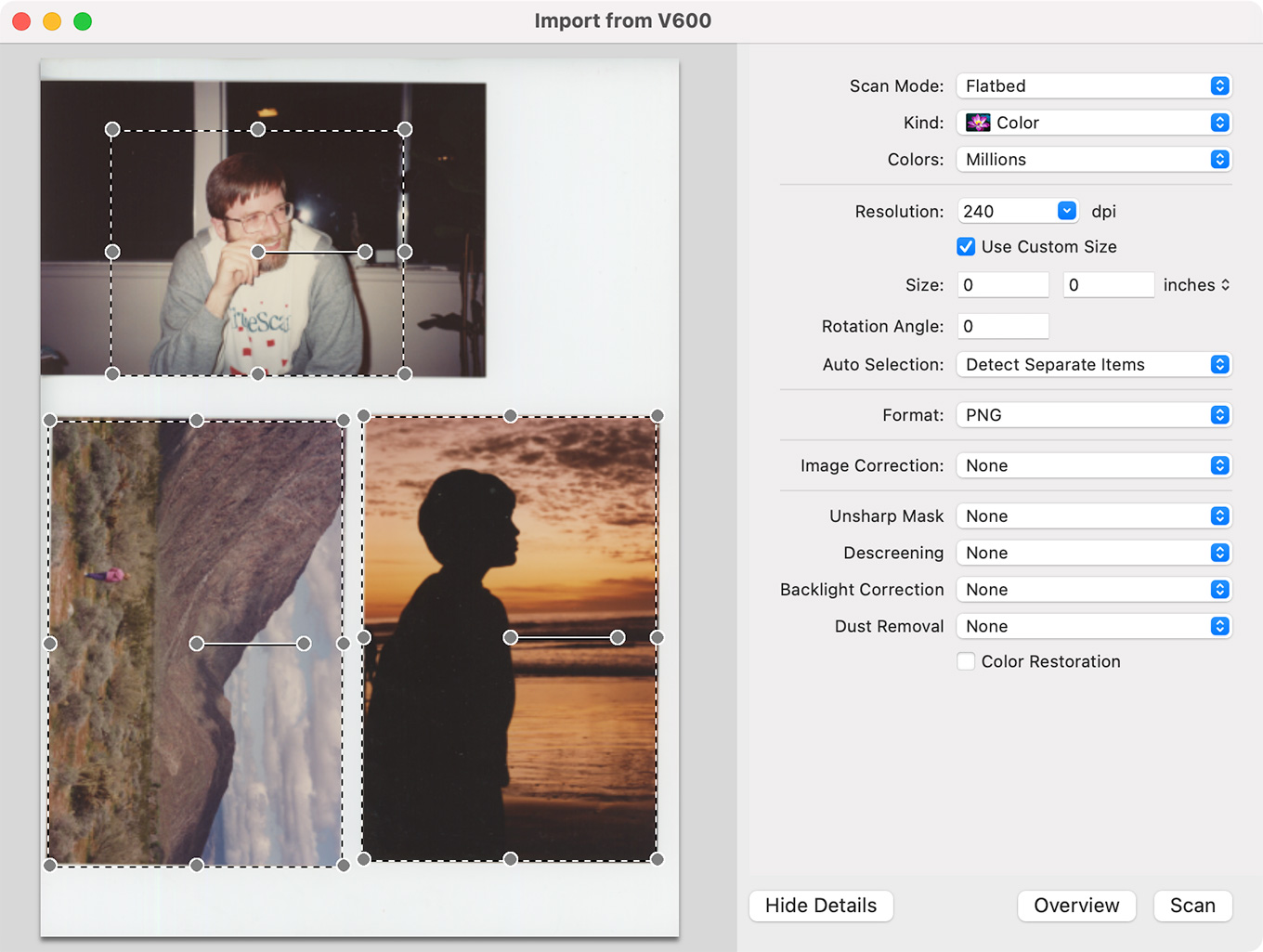
For simple, easy and accessible software, you can scan directly from Preview. This is a fast way to digitize a document into a variety of formats, include PDF, JPEG, PNG and TIFF. But, it provides a minimum of control.
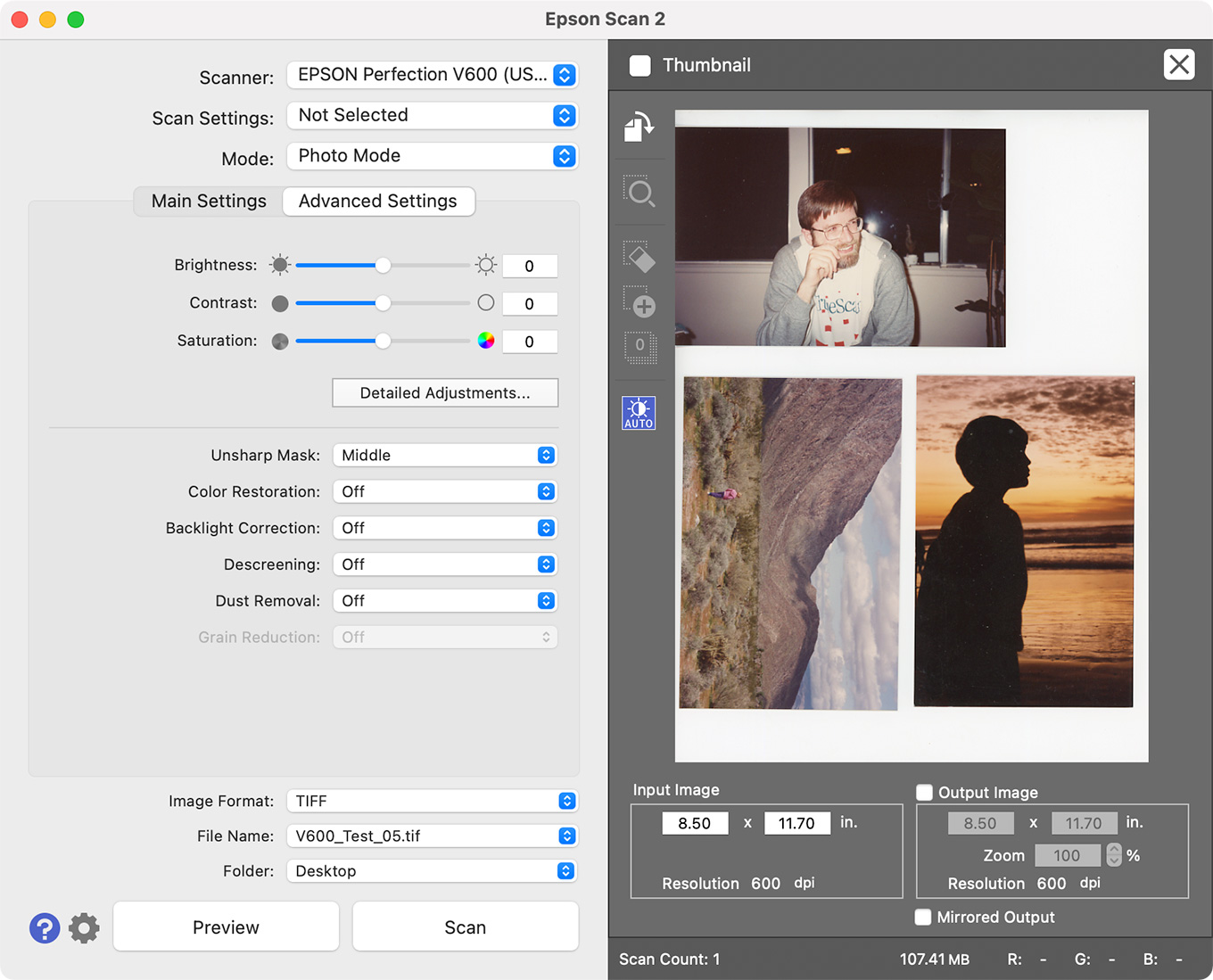
The next level up is Epson Scan 2. This software is bundled with all Epson scanners. It is flexible with a variety of features, but recent versions have emphasized ease of use, making advanced features harder to access or unavailable.
I used to use this all the time. But, not any more.
At what I consider the professional end of image scanning are two pieces of software: VueScan and SilverFast. Both have devoted audiences and have been around for a long time. Both do excellent work. VueScan’s biggest claim to fame is its support for more than 6,000 scanners. However, I find the image adjustment controls in VueScan lacking.
My preference, after using both for a while, is SilverFast. While it still clearly shows its roots in scanning images for print, the quality of its scans can be outstanding. However, its interface, automatic settings and help files need more work.
EXECUTIVE SUMMARY
LaserSoft Imaging began development of SilverFast more than 30 years ago. The current version is 9.2.1 which runs on M1 Macs and Monterey as well as older devices. SilverFast SE 9 supports more than 340 scanners, Mac and Windows, and comes in three versions:
NOTE: LaserSoft also offers SilverFast Archiving software, which is a comprehensive archiving tool for scanning photos in a lossless RAW format, which can then be accessed later for processing and image clean-up.
The strength of SilverFast is the quality of the images it creates. However, the software itself assumes that scans are principally used for print, rather than the web. The interface is hard to learn, with out-of-date user manuals and automatic settings that yield sub-optimal results. Using its Workflow Pilot for high-quality scans for video is an exercise in futility.
If you take the time to learn the interface, you will create images that are superior to anything else I’ve seen. However, this is software the succeeds in spite of its interface, not because of it.
Developer: LaserSoft Imaging
Product: SilverFast SE Plus 9
Website: https://www.silverfast.com/scanner-software/
Price: $99 (US)
A free trial is available for all versions.
LICENSES
LaserSoft licenses its software by scanner. So, you need one SilverFast license for each scanner attached to your computer. I have two scanners, so I need two licenses. Once licensed, SilverFast can switch between multiple scanners attached to the same computer.
SilverFast can be installed on up to three computers at the same time; licenses are managed from the MySilverFast.com website. SilverFast requires access to the web for license activation; as well, it needs to log onto the web every 90 days or so to renew the license.
Installing the software isn’t hard, but it requires creating an account on MySilverFast.com, downloading the software, purchasing a license and getting everything installed. The process took about an hour and LaserSoft provides a web-based tutorial on what you need to do to complete the installation.
NOTE: LaserSoft also provides a “First Steps” Guide to installing and running SilverFast. This free guide is what I used to get up and running.
THE INTERFACE
This is the SilverFast interface. Yeah, it’s a bit overwhelming.
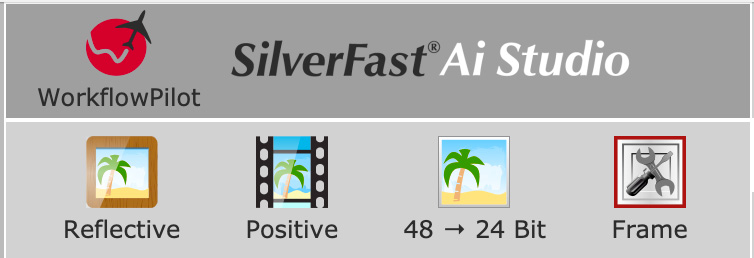
Up at the top left is a red icon. This is the Workflow Pilot – a streamlined interface designed to help you create high-quality scans quickly, without getting lost in the tools. Click the red icon to enable this or, when it turns blue, click it again to turn it off.
NOTE: Although this review is for SilverFast SE Plus 9, you may see that I have the AI Studio version. I upgraded in the middle of this review, but I am not using any of the higher-end features in this review. Nor, for that matter, would I necessarily recommend the AI version over SE Plus 9.
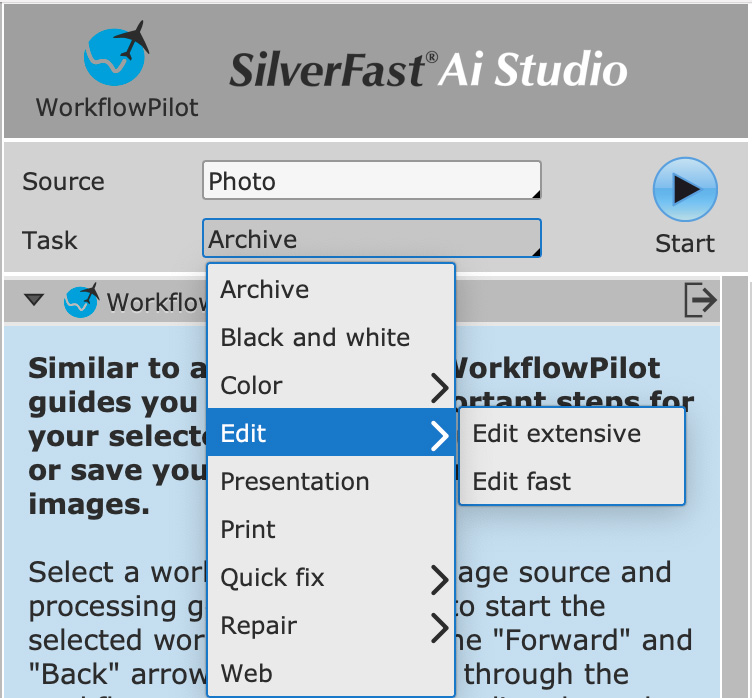
When active, Workflow Pilot provides a number of presets, along with on-screen instructions on each option.
The underlying assumption of the Workflow Pilot is that you are scanning for a specific task – print, web, video and so on. The problem this creates is that I often want to create a high-resolution master scan of my image, say for doing pan-and-scan work within a documentary video. The Workflow Pilot does not know how to deal with an image where the ultimate size of the finished scan is unknown. (Archive is an exception, but this has a significant limitation, which I’ll explain shortly.)
I find that I’m working against the Workflow Pilot more than it is enabling me to get my work done quicker. It may make scanning easier for newbies who are scanning images for fixed sizes for clearly defined purposes, but I find the Pilot too limiting.
SCANNING A PHOTO AS AN ARCHIVE
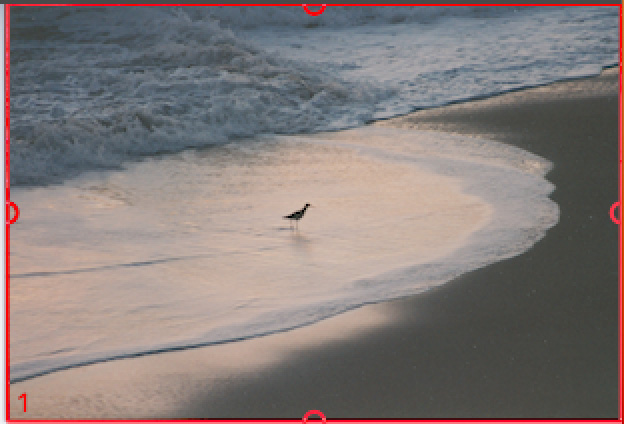
I mentioned that SilverFast scans images for archiving. However, to take full advantage of the recovery and repair features built into an archive scan, you also need to purchase SilverFast HDR.
If you don’t need image repair settings saved with the file, you can create a RAW file of the scan which can then be opened in Photoshop. The problem is that an archive looks terrible when you open it in Photoshop. The image above is what the image looks like in SilverFast preview (and, for that matter, in real life).
Here’s what the archive looks like in Photoshop. Shadows are crushed, highlights are way over-extended. Yes, I understand RAW images need adjustment, but look at the shadows – there’s no easy way to recover that data.
Worse, when scanning as an archive, SilverFast does not allow any image adjustments or dust removal settings prior to the scan. It assumes those will be made later using the SilverFast HDR software. However, those options are lost when the file is opened in Photoshop.
Creating archives is fast, but you’ll spend far more time trying to fix them later than you save in the original scan. Time to look at a different option.
SCAN A PHOTO MANUALLY
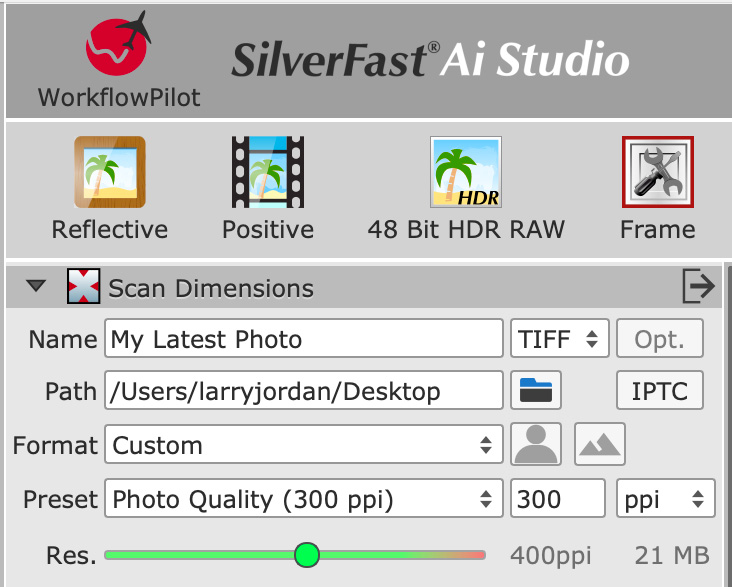
Instead, let’s get into the real reason for using SilverFast, creating high-quality image scans using the manual settings.
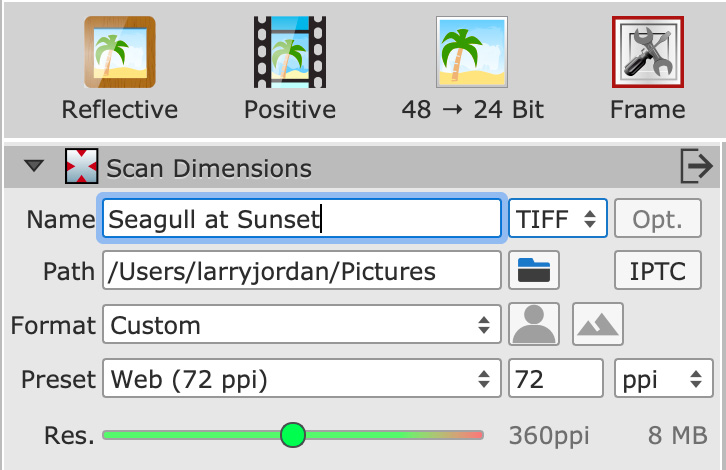
Across the top left are four buttons that determine the type of scan: Reflective vs. Transparency, Positive vs. Negative film, Color bit depth and Frames, which defines the area of the image to be scanned.
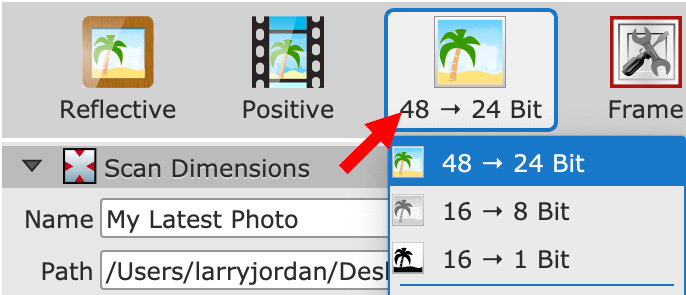
The first two choices are obvious, and the default setting of 48 > 24 Bit is a good one for most scans. Color prints have a very limited color range, so this setting is fine. Well-exposed, color saturated slides – especially large format negatives or prints – may benefit from a full 48-bit color bit depth which requires the AI Studio version.
For my slides, I find the 48 > 24 Bit setting perfectly acceptable.
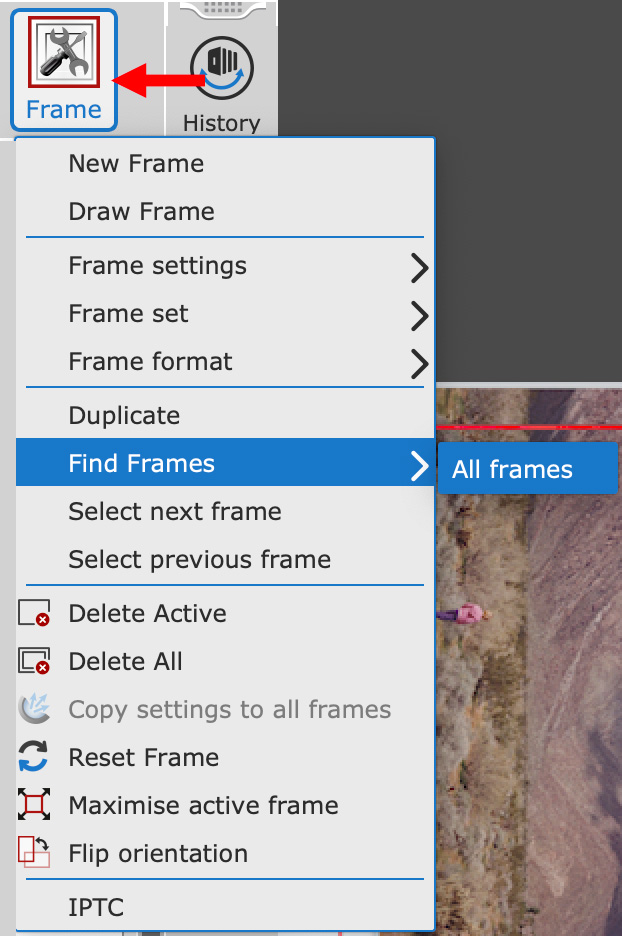
After completing a pre-scan (described below) click the Frame button and choose Find Frames > All Frames. This sets scanning boundaries (frames) around each image automatically. Just like cropping rectangles in Photoshop, these boundaries determine what part of each image will be scanned and can be resized, repositioned and rotated.
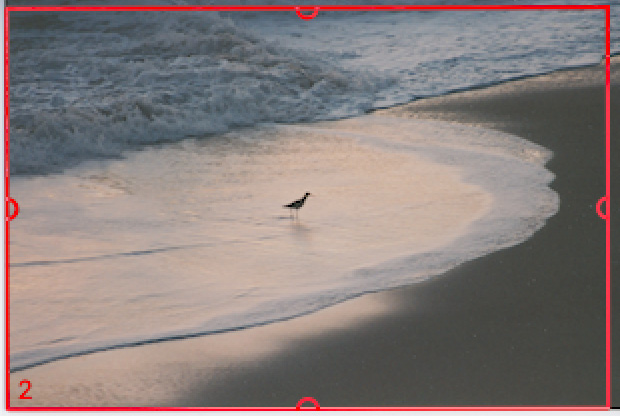
Frames are indicated by red rectangles. I found this feature works perfectly with slides, but it is less accurate defining the boundaries of prints. However, adjusting these manually is easy.
Below these four buttons is Scan Dimensions where we add:
NOTE: Changing the Preset also resets the Res (scanning resolution). This can cause unpleasant surprises, be sure to set Preset first!
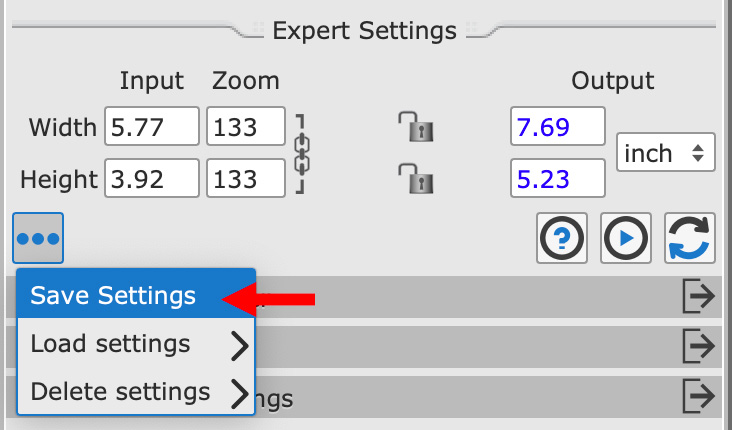
We can save, load and delete these custom dimension settings, as illustrated by the red arrow in the screen shot above.
![]()
These three buttons appear in many areas throughout the program:
The only problem is that the User Manual links to version 8, not version 9. I have not found any accurate online reference guide to using the features in SilverFast SE version 9; aside, perhaps, from an eBook the company is selling on its website.
PREVIEW THE SCAN

The buttons across the top display commonly used settings:
Other settings in this top menu bar include:
It’s nice that their is this level of color correction. But, to me, the purpose of any scanning software is to capture the image as accurately as possible, without losing any detail in the shadows, highlights or colors and without creating a color cast of its own.
While we can save custom scanning dimensions as presets, we can’t save adjustment panels or presets to apply to an image. This is a big limitation – but there’s a work-around:
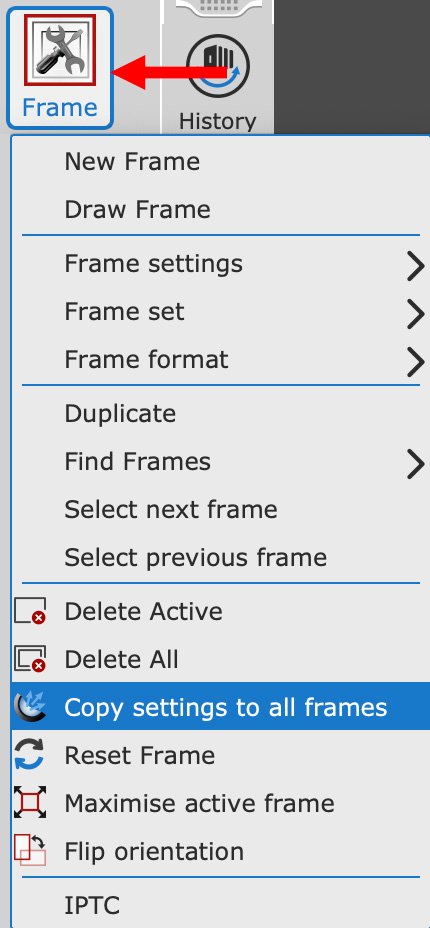
Select the first image and apply whatever panels and settings that you want, then, choose Frames > Copy Settings to All Frames. This applies those settings to all the other frames. I’ve found this step saves me a lot of time when scanning similar images or, especially, slides.
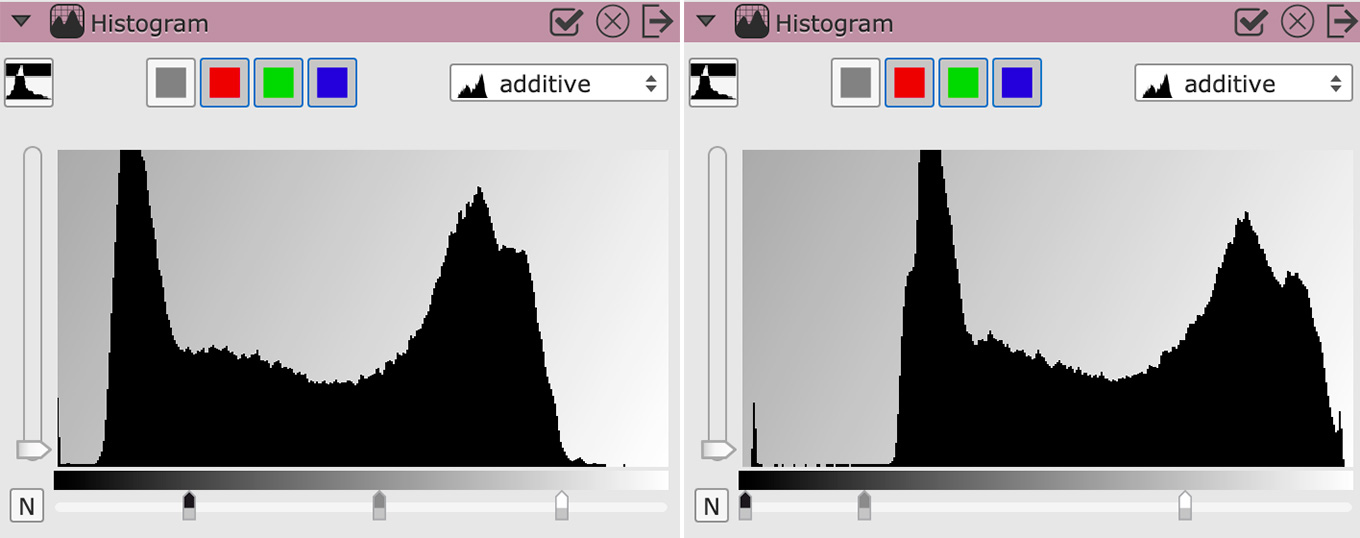
But, there are issues when using these automatic settings. Here are two examples of the Auto setting applied to two different photos. Notice how in both cases, the Histogram shows the highlights or shadows getting crushed. This is not why we buy a high-end scanner.
NOTE: These are caused by using the automatic settings. Adjusting these settings manually is not a problem.
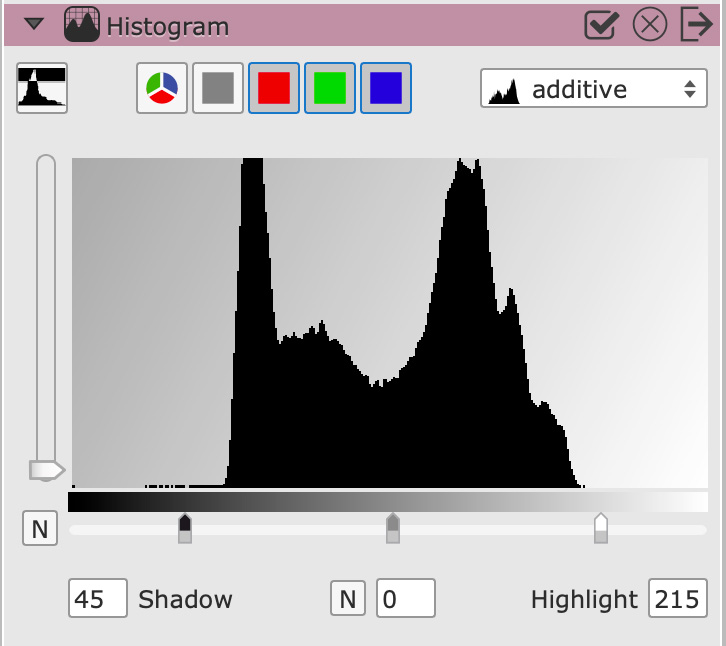
Compare the crushed setting in the Histogram with a manual setting where all detail is preserved. Yes, this means that we would still need to tweak this image in Photoshop – but, the KEY is that all grayscale detail is preserved in the scan. I would never expect the scan to be my finished image.
NOTE: When using the Histogram for scanning, adjust the shadow and highlight levels so that they are close to, but don’t cut into, the pixel range displayed for the image. You want to get the maximum value from your image, without losing detail. Mid-tones can be set to whatever looks good to you.
For this reason, while I would like to use Auto just to save time, it is critical that you check the histogram settings after applying this toolbar option to make sure you aren’t losing detail in the image.
The good news about using the Auto setting is that you can see the changes SilverFast made to the Histogram. However, this is not true for the Global CC color correction setting. The program tweaks colors, but doesn’t indicate what changes it made. I would be much happier with this feature if I could see what it did and then adjust it as necessary. Because these color changes are made blind, I don’t use it.
THE MIDDLE TOOLBAR SETTINGS

The middle toolbar contains the tools that are the reason I use SilverFast:
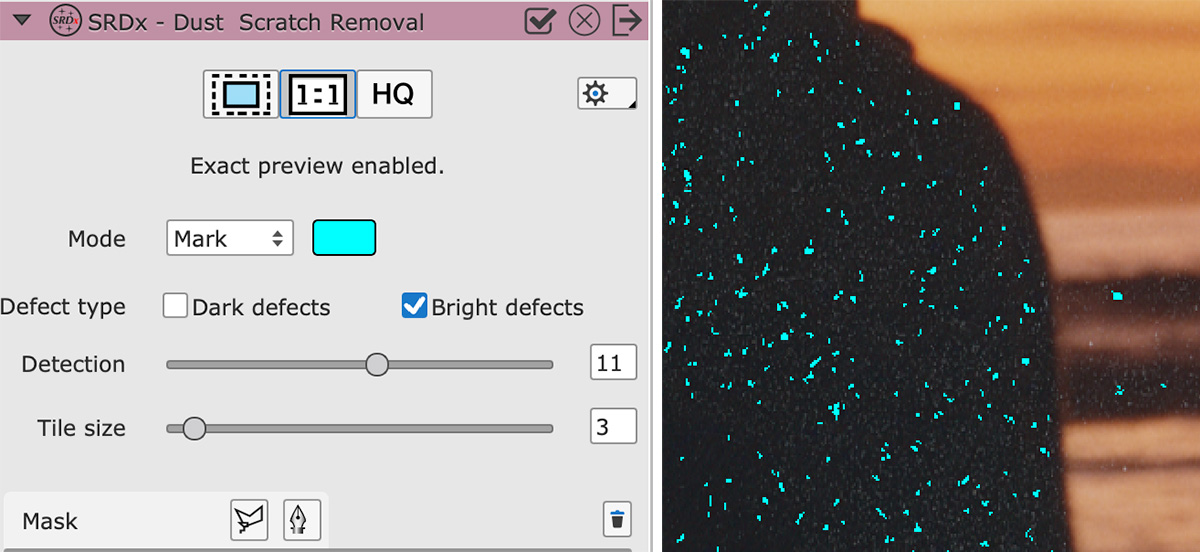
NOTE: Use SRDx for prints and iSRD for slides. You’ll see examples shortly.
In my scans, I regularly use:
However, as mentioned earlier, it is not possible to set these as a default or preset.
SCANNING
When it is time to scan, clid the Scan button to scan whichever individual image is active; that is, highlighted with a red rectangle.
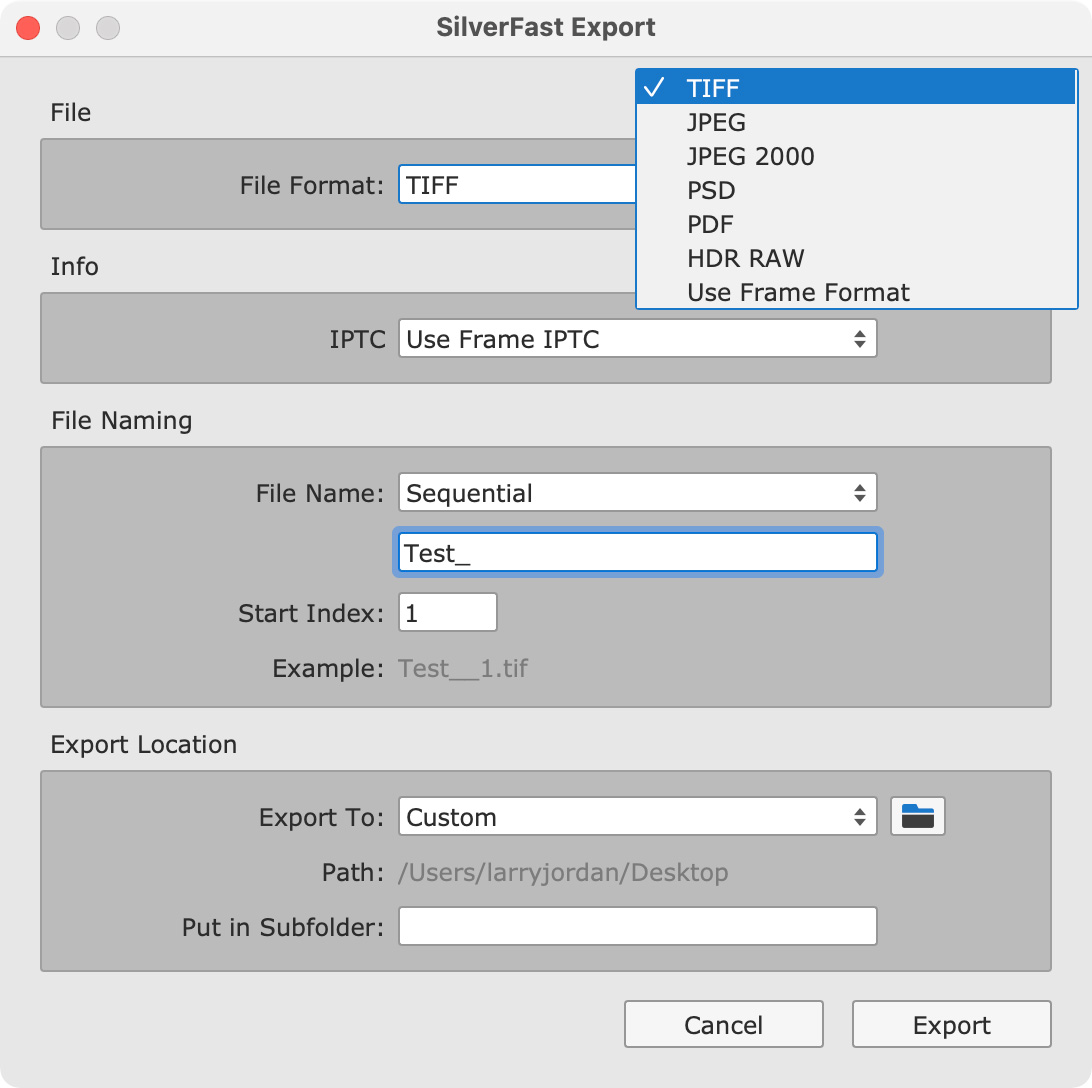
Or, click Batch to scan all the slides to display the Batch Scanning window (above).
NOTE: The Batch window ignores any file names or path names in the Scan settings. This, too, is a trap because you think you already set it, but the existing Path name in Scan Dimensions is not shared with the Batch window.
COMPARING RESULTS
Here are four examples comparing the scanning features of SilverFast. NO adjustments or corrections were made to the image after scanning.
NOTE: Because the largest image WordPress allows me to post is 2560 pixels on a side, I combined and scaled these images in Photoshop. No other adjustments or retouching were made to any image in Photoshop.
In this first example, we see the difference when SRDx dust removal is enabled and adjusted. Top right is the scan without enabling dust removal. In the left image, the blue dots indicate white dust that will be removed by this feature. (This setting needs to be adjusted manually to determine what’s dust and what’s essential image information.) The lower right image shows the results after dust removal. (This will be easier to see on the larger image.)
This image compares the source image (top) with an automatic exposure adjustment (middle) or manual adjustments (bottom). Both the automatic and manual settings use the histogram to alter grayscale settings and you can alter the automatic settings manually after they are applied.
The safest approach to scanning an image is to make grayscale changes that provide the widest latitude later when you are processing the final image in Photoshop. My general practice is to make the image look as good as possible without losing image detail. The bottom scan looks lovely, but that level of adjustment might better be made in Photoshop.
This image compares an automatic and manual color correction to a source image. I generally tend to adjust color later in Photoshop, but SilverFast provides tools to make color adjustments to the image before the scan.
When you take the time, though, you can get some great looking images. This image compares both automatic exposure and color correction to using the tools manually. Specially, the image on the right includes adjustments for:
When you pay attention to the settings, you can get amazing scans, even when the original prints are not that good. This level of control is why I use the software.
SCANNING SLIDES
When scanning slides, set:
Then copy those settings to all other frames.
Slides, like prints, can be scanned to TIFF, PSD, PDF and JPEG formats. However, SilverFast does not support PNG.
This showcases the benefit of using iSRD for removing dust. Notice how much dirt was removed from what appeared to be a “clean” slide during the scan.
NOTE: iSRD can only be used with slides or other transparencies. Not all scanners support this function, which requires scanning the slide using infrared light. SRDx should be used to remove dust from prints.
With these settings, it takes a few minutes to scan a slide, but, again, the results are worth it. The good news is that SilverFast can run in the background, so you can do other work while the software is busy scanning slides.
THINGS I’D LIKE TO SEE
SilverFast lives up to its reputation for creating high-quality scans. But its interface is far too print-centric. I live in the world of video and web and the interface keeps getting in my way. Here’s what I would like to see in the next version:
SUMMARY
SilverFast SE Plus 9, by LaserSoft Imaging, provides high-quality image scans for professional use. However, it has an interface that takes time to learn. Sadly, many of the automatic settings yield poor results.
Just like learning how to color grade in an NLE takes time, the time you spend learning the SilverFast interface returns value multiple times over with the ability to improve the look of your images.
SilverFast is far superior in terms of control and image quality to Epson Scan 2, especially in noise and dust removal. It takes time to learn and there’s a lot about the interface that needs improvement, but the results are what matter. And the results can be excellent.
30 Responses to Review: LaserSoft SilverFast 9 SE Plus Scanning Software
← Older Comments-
 Charlie says:
Charlie says:
April 12, 2024 at 2:21 pm
-
 Larry says:
Larry says:
April 12, 2024 at 2:23 pm
-
 Chris says:
Chris says:
August 15, 2024 at 11:06 pm
-
 Larry says:
Larry says:
August 16, 2024 at 3:55 am
← Older CommentsVery much appreciate your review and information. I am using VS 9 Studio with a Plustek 8300i and have almost no prior experience with scanning film. Even so, I have been able to produce a few very interesting results from my 35mm color negatives of 30 years ago. I am looking forward to a lot more studying and improving my understanding and effective use of VS an Plustek in future. Trying to decide whether to purchase the online user manual (agree it shopuld be included)
Charlie:
I haven’t purchased the manual, but if you are new to scanning and all the settings in Silverfast, I think it would be a very good investment for you.
Larry
Thanks for this great review! You mention “Nor, for that matter, would I necessarily recommend the AI version over SE Plus 9.”
Could you elaborate on why you wouldn’t recommend it, despite purchasing it yourself? What does one gain from the AI version that is missing from Plus, but isn’t worth the upgrade?
It would also be interesting to see a review of the archiving version you allude to.
Chris:
Clearly, if money is no problem, buying the AI version ($249) compared to the SE Plus version ($99) is perfectly fine. However, for most people scanning for video or the web, the features in the AI version (JobManager, automatic IT8 color calibration, expert mode and a 16-bit histogram) are not features that most video folks need. Here’s a Silverfast web page with more details:
https://www.silverfast.com/download/docu/silverfast9versioncomparisonchart_en_2020-10-20.pdf
The archive feature allows scanning an image, then storing that scan data until you can convert it into an image later using SilverFast. Storing scan data is not as useful to me as storing the image. this is why I haven’t reviewed it.)
Larry